15 Lilies Flowers Guide To Types, Care, And Arrangement Tips
Lilies are popular flowers known for their beauty and variety. They come in many shapes, sizes, and colors, making them a favorite for gardeners and flower lovers. Lilies also add fragrance and elegance to gardens and floral arrangements.

This article highlights 15 types of lilies that are well-loved for their unique features and ease of growing. It helps readers discover different lily kinds and what makes each one special without being too complicated.
1) Oriental Lilies
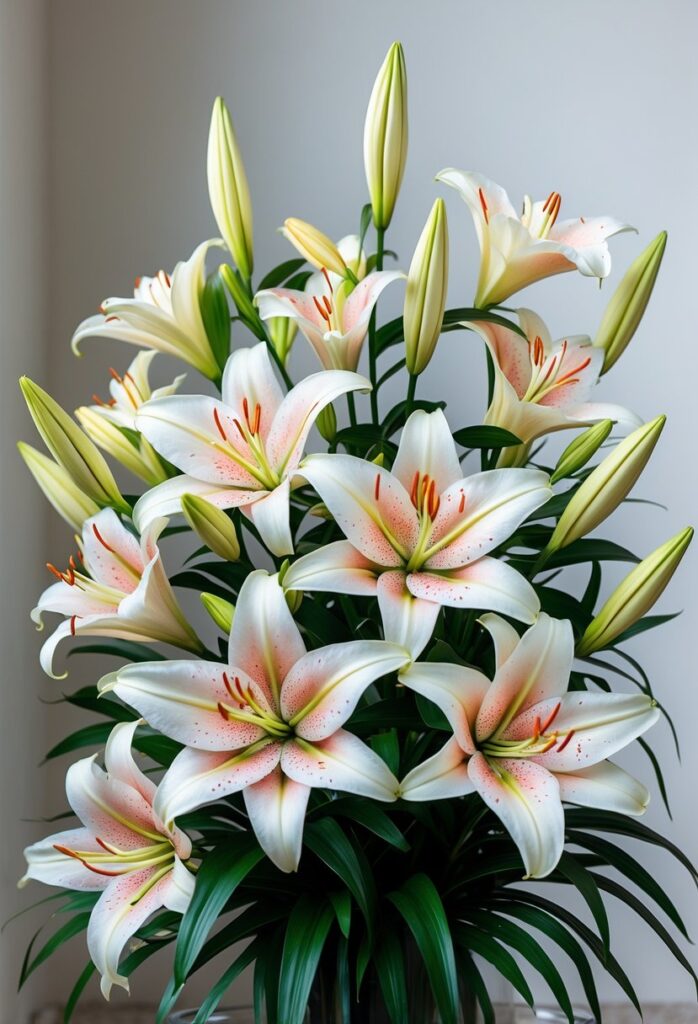
Oriental Lilies are known for their large, showy flowers that often measure 6 to 9 inches across. They usually have strong, sweet fragrances that can fill a garden. The colors of these lilies include shades of pink, white, red, and purple, often with speckles or ruffled edges on the petals.
These lilies grow from bulbs and can reach heights up to 48 inches. Their stems are thick and sturdy, supporting the large blooms well. The leaves are lance-shaped, which adds to their elegant appearance.
Oriental Lilies bloom later than Asiatic Lilies, usually appearing in August. They prefer moist soil and plenty of sunlight. Their thriving growth and lasting blooms make them popular for both gardens and cut flower arrangements.
They are hybrids created by crossing several species from Asia, especially Japan. Their rich colors and strong scent make them a favorite among gardeners who want bold and fragrant flowers.
2) Asiatic Lilies
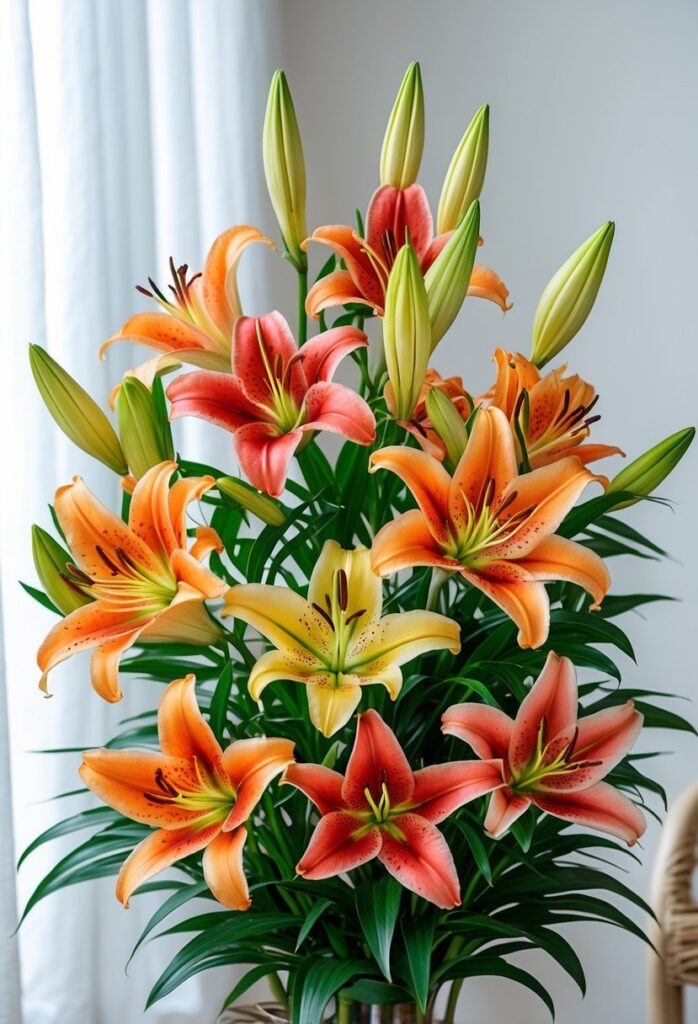
Asiatic lilies are popular garden flowers known for their bright, bold colors. They bloom in late spring or early summer. The flowers range in color from orange, yellow, and red to pink and white.
These lilies grow on tall, sturdy stems that reach 2 to 5 feet in height. Their flowers are about 4 to 6 inches wide and often have smooth-edged petals. Some varieties also have spots or contrasting edges on the petals.
Unlike Oriental lilies, Asiatic lilies have little to no scent. They are hardy and easy to grow, making them a good choice for both new and experienced gardeners.
Asiatic lilies thrive in full sun and well-drained soil. They can be planted in early spring or fall. Dividing the bulbs every few years helps keep the plants healthy and promotes better blooming.
Their wide range of colors and strong stems make Asiatic lilies a versatile option for many garden styles. They work well alone or combined with other flowers to create vibrant displays.
3) Trumpet Lilies
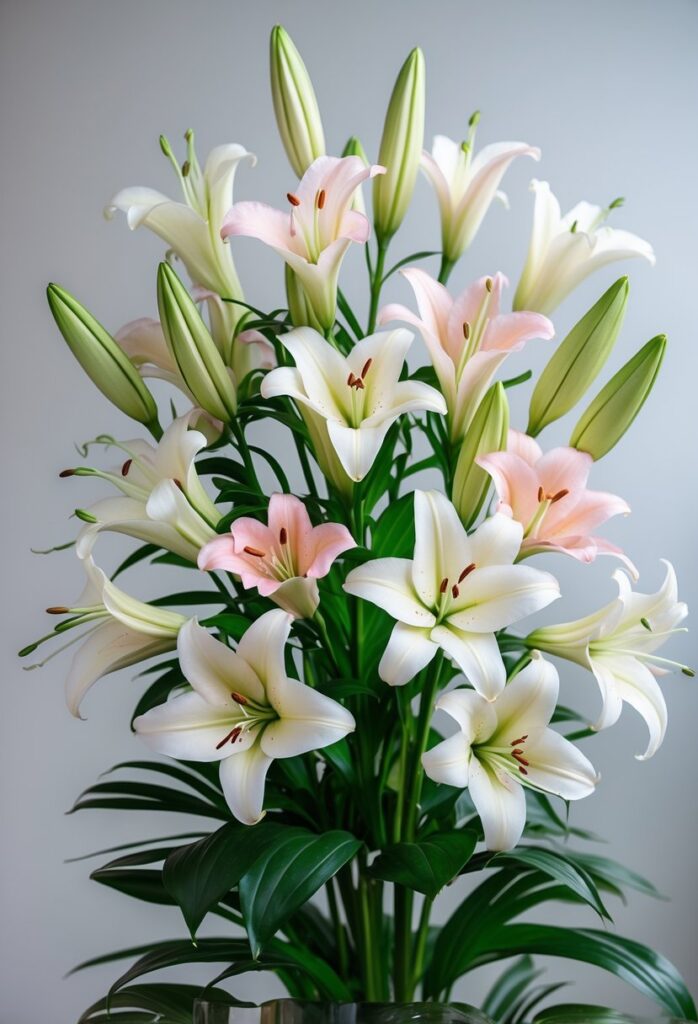
Trumpet lilies are known for their large, trumpet-shaped flowers. These blooms can be 6 to 10 inches long and often have a strong, sweet fragrance.
They come in many colors, such as white, yellow, and pink. Some varieties have contrasting petals with different colors on the outside.
These lilies can grow quite tall, reaching up to 6 feet in height. Because of their height and size, they may need staking to prevent the stems from falling over.
Trumpet lilies are popular for gardens and containers. When planting, bulbs should be spaced 4 to 6 inches apart and planted 8 inches deep in well-draining soil.
They bloom in mid to late summer. Their flowers last long in the garden and are also good for cutting and displaying in vases.
These lilies prefer full sun to partial shade. With the right care, they produce many large, fragrant flowers on each stem, making them a striking addition to any garden.
4) Martagon Lilies

Martagon lilies, also called Turk’s Cap lilies, have unique flowers that curl backward, resembling a Turkish hat. They come in soft colors like pink, white, and purple, often with spots on the petals. These lilies grow naturally in parts of Europe and Asia.
They prefer dappled shade and do well in rich, moist soil. Once planted, martagon lilies need little care and can bloom year after year. Their flowers hang downward and attract bees and butterflies.
Martagons are slow to start but form larger clumps over time. They do not like being moved often, so gardeners should plant them carefully. These lilies add elegance to shaded garden spots where their muted colors blend well with other plants.
5) Stargazer Lilies

Stargazer lilies are a popular type of oriental lily known for their large, bright pink flowers with white edges. They have a strong, spicy scent that many find appealing. These lilies stand out in gardens or as cut flowers.
They grow best in full sun with well-draining soil. Stargazer lilies need about 1 to 2 inches of water each week. They can be planted in garden beds or containers, making them versatile for different spaces.
These lilies attract butterflies and hummingbirds, adding life to outdoor areas. They are also perennial, meaning they can bloom year after year if cared for properly.
Planting stargazer lilies in pots allows for easy control of soil and light. They can be left in the same pot for a few years. Proper watering and sunlight help produce strong stems and vibrant flowers.
Overall, stargazer lilies are a solid choice for those wanting colorful, fragrant flowers that are fairly easy to maintain.
6) Tiger Lilies
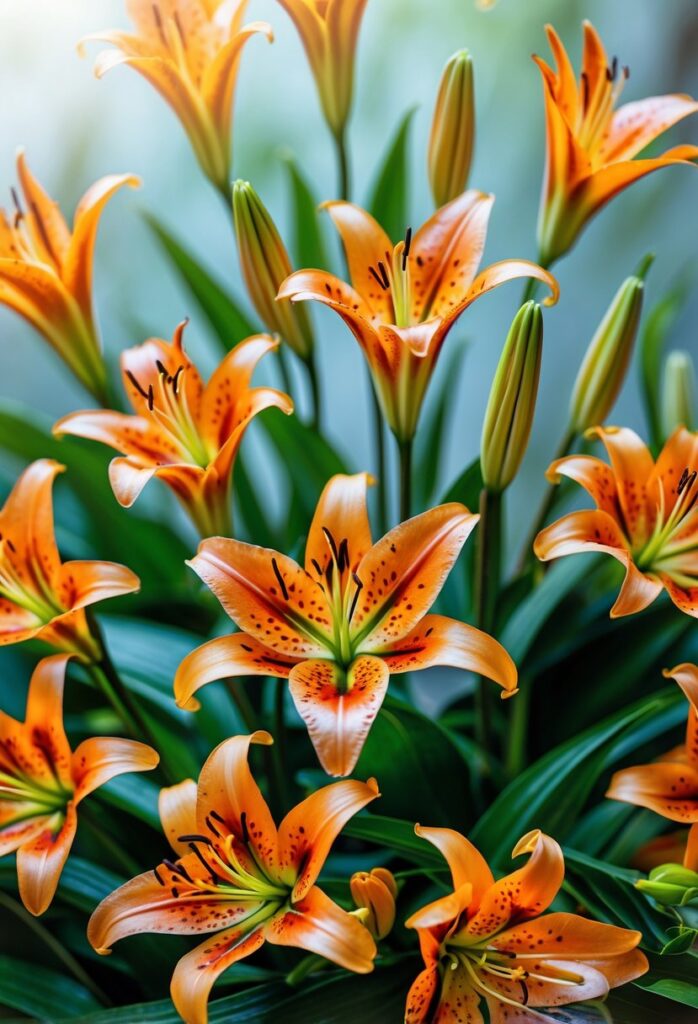
Tiger lilies (Lilium lancifolium) are known for their bright orange petals covered with dark spots. They are tall plants, often growing between 2 and 6 feet high. The flowers have a unique curved shape, which adds a wild look to gardens.
These lilies are perennials, meaning they come back every year. They grow from bulbs and produce small bulbils along their stems. Gardeners can use these bulbils to grow new plants.
Tiger lilies prefer well-drained soil and need at least six hours of sunlight. They are low-maintenance and can thrive in many garden settings, including cottage and wildflower gardens.
They usually bloom in summer and last about six to eight weeks. Because of their bright color and striking form, tiger lilies add vibrant interest to garden spaces.
7) Easter Lilies

Easter lilies, known scientifically as Lilium longiflorum, are widely recognized for their pure white, trumpet-shaped flowers. They bloom in spring and are closely linked to Easter celebrations.
These lilies symbolize purity, renewal, and hope. Their elegant shape and bright white color make them popular in homes, churches, and gardens during the season.
Easter lilies grow best in well-draining soil with regular moisture. They thrive in USDA Hardiness Zones 4 through 8 and can reach about 3 feet tall.
Because of their height and large flowers, they sometimes need support to prevent flopping over. Gardeners often place them where stems can be protected or supported.
Healthy Easter lilies can produce 12 to 15 flowers per plant. They bring a clean, fresh look to any space, making them a favorite for spring decoration.
8) Orienpet Lilies
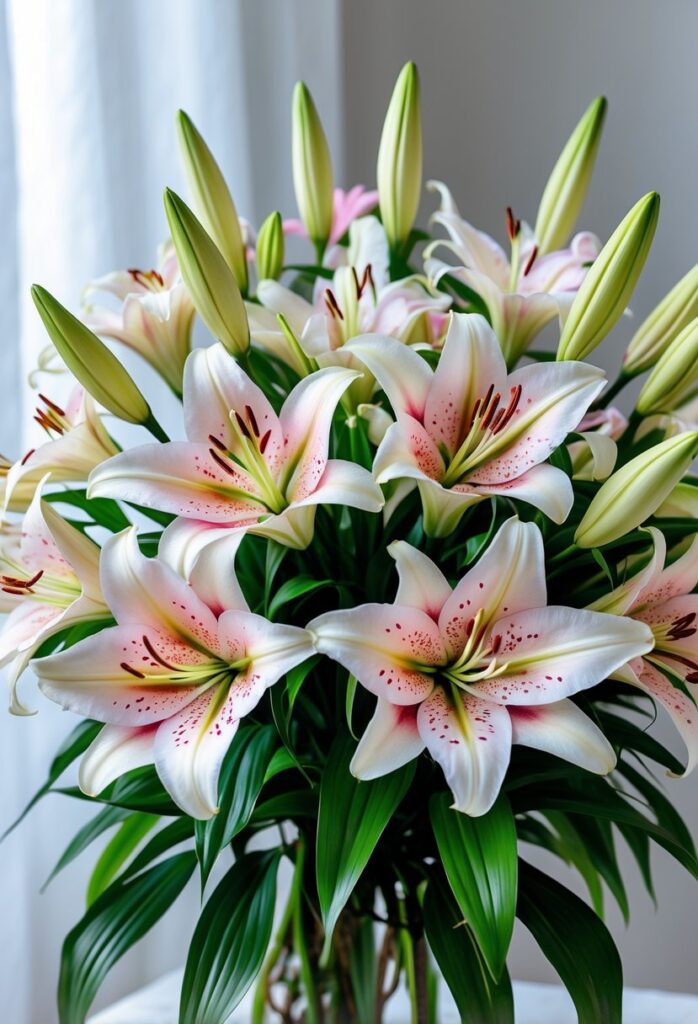
Orienpet lilies are a hybrid between Oriental and Trumpet lilies. They combine features from both types, such as large, fragrant flowers and strong stems. These lilies grow tall, often reaching between 3 to 8 feet high.
The blooms are bright and showy, with colors ranging from soft pastels to bold shades. Their flowers face outward and upward, making them stand out in gardens. They also tend to bloom earlier than pure Oriental lilies.
Orienpet lilies are more tolerant of tough growing conditions. They can handle different climates and still perform well. This makes them a good choice for many gardeners.
These lilies give off a sweet fragrance, which adds to their appeal. They are often used in flower beds and as cut flowers indoors. With proper care, including regular feeding during the growing season, they can thrive for many years.
9) Lilium Candidum (Madonna Lily)

Lilium candidum, also known as the Madonna lily, is a tall perennial plant that can grow up to 6 feet. It has glossy dark green leaves and pure white, trumpet-shaped flowers that measure about 3 inches long. The flowers bloom in early summer and are highly fragrant.
This lily is native to the eastern Mediterranean but has been cultivated in many regions for over 3,000 years. It holds symbolic value in different cultures and is often admired for its simple beauty and sweet scent.
The plant attracts pollinators like bees and butterflies. It grows well in well-drained soil and needs full sun or partial shade. Compared to other lilies, it has slightly different care requirements but is generally easy to grow.
Madonna lilies have been used in gardens and art for centuries. Their striking white flowers create a classic and elegant appearance, making them popular in floral arrangements and outdoor spaces alike.
10) LA Hybrid Lilies
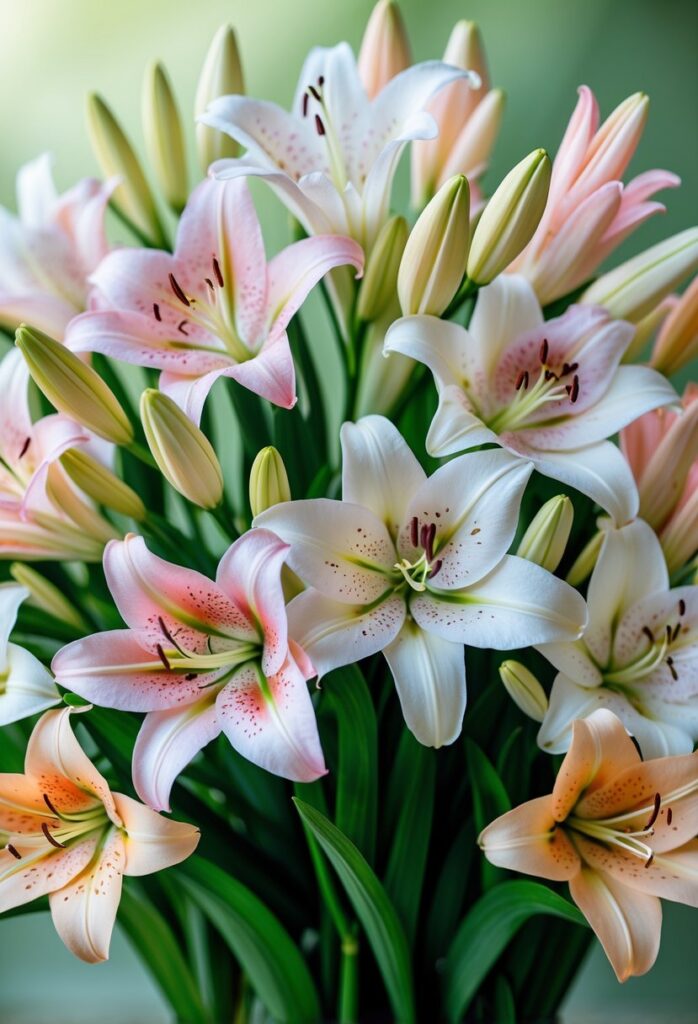
LA Hybrid Lilies are a cross between Asiatic Lilies and Easter Lilies. This hybrid combines traits from both types, resulting in flowers with large, funnel-shaped blooms. They usually have a light fragrance that is more subtle than that of Easter Lilies.
These lilies have strong, upright stems and produce long-lasting flowers that stay fresh longer than typical Asiatic Lilies. The petals are thicker, making them more resistant to weather damage.
Gardeners appreciate LA Hybrid Lilies for their bright colors and sturdy growth. They work well in garden beds, borders, and large containers. Their flowers are also popular for use in bouquets due to their durability.
The name “LA” stands for Longiflorum-Asiaticum, referring to the species crossed to create them. They tend to have fewer blooms per stem than Asiatic Lilies but make up for it with larger, showy flowers.
LA Hybrid Lilies grow well in many climates and can return year after year when planted in suitable conditions. They respond positively to care techniques that control height and improve flowering.
11) Turk’s Cap Lilies

Turk’s Cap Lilies are a type of Martagon lily known for their downward-facing flowers with petals that curve back like a Turkish turban. The petals often have spots or freckles, adding to their unique look. These lilies usually bloom in early to mid-summer.
They grow well in zones 4 to 9 and prefer shady to partly sunny spots. The soil should be rich in organic matter, moist, and well-drained to prevent root problems. Consistent watering helps them produce healthy flowers.
The flowers come in colors such as orange with purple spots, burgundy, white, and various shades in between. The tall stems are covered in whorls of narrow leaves, making the plant stand out in the garden.
Turk’s Cap Lilies are hardy perennials that attract pollinators like butterflies. They can grow in forests, swamps, and other natural areas but also do well in well-prepared garden beds. They add height and color without needing much care.
12) Formosan Lilies

Formosan lilies, known scientifically as Lilium formosanum, are native to Taiwan. They grow tall, often reaching 4 to 7 feet in height. Their large white flowers bloom from late summer to fall.
The flowers are trumpet-shaped and give off a sweet fragrance. Each flower can be 6 to 12 inches long. They usually appear in small groups on a single stem.
These lilies prefer full sun but can tolerate some shade. They produce seed pods after flowering, which contain many thin, papery seeds. The seed pods can last into the winter.
Formosan lilies are related to Easter lilies, but their flowers bloom later and are more funnel-shaped. They are often grown for their striking appearance and scent in gardens.
13) Golden-rayed Lilies

Golden-rayed lilies, known scientifically as Lilium auratum, are native to Japan. They are prized for their large, white flowers marked by a distinctive gold band down the center of each petal. Some flowers can reach up to 10 inches across.
These lilies bloom in mid to late summer, usually from July to August. Each stem can hold up to 12 to 14 flowers. The blooms face outward and slightly downward, giving them a graceful appearance.
The flowers have a strong, sweet fragrance that can fill a garden. This scent helps attract butterflies and other pollinators. The golden-rayed lily prefers sunny or partly shaded spots, especially in warmer areas.
The plant can grow between 2 to 5 feet tall. It is a perennial species that thrives in well-drained soil. Gardeners should take care, as the lily’s leaves and flowers can be toxic to cats if ingested.
Historically, these lilies have cultural importance in Japan, where they are seen as sacred. Their bulbs are also used in some Japanese and Chinese cooking.
14) Lily of the Valley
Lily of the Valley is a small, shade-loving perennial plant. It produces delicate, bell-shaped flowers that are usually white but sometimes have a pink hue. These flowers appear in spring and grow in clusters on upright stalks.
The plant has shiny green leaves that grow close to the ground. It is known for its strong, sweet fragrance, which makes it popular in gardens and floral arrangements.
Lily of the Valley prefers cool, shady areas and moist soil. It spreads slowly by underground rhizomes, which helps it form a natural ground cover.
Although it has been used in traditional medicine, the plant is toxic if ingested. It requires careful handling around pets and children.
After flowering, the plant produces small red-orange berries, which contain seeds. These berries are also poisonous.
Lily of the Valley adds a charming and subtle beauty to gardens with its neat appearance and gentle scent.
15) Easter Lily Plant Care
The Easter lily needs bright, indirect sunlight to grow well. It prefers a cool environment but not freezing temperatures. Keeping the soil moist without waterlogging is important for healthy growth.
Planting Easter lilies in well-draining, rich soil helps prevent root rot. They grow best in USDA Hardiness Zones 4 to 8. After blooming, the plant can be placed outdoors where it can lean against other plants for support.
Easter lilies can be kept indoors as potted plants or planted in the garden. Regular watering and good air circulation help them stay fresh longer. The bulbs are hardy in mild winters but the green parts need protection from frost.
This plant is toxic if eaten, so it should be placed away from pets and small children. If cared for properly, an Easter lily can bloom again in future seasons.
Symbolism and Cultural Significance of 15 Lilies Flowers
Lilies carry deep meanings that vary by culture and tradition. They often represent ideas like purity, love, and renewal. Different types and colors of lilies hold unique messages, making them important in many ceremonies and beliefs.
Traditional Meanings in Different Cultures
In Western cultures, white lilies symbolize purity and are often linked to the Virgin Mary in Christian traditions. They also represent the soul’s restored innocence after death.
In Chinese culture, lilies signify a happy union, especially in weddings. The word for lily sounds like a phrase meaning “a hundred years of happiness,” which makes them popular for love and marriage symbols.
Greek mythology connects lilies with Hera, representing motherhood and rebirth. In Egypt, lilies were seen as a symbol of fertility and renewal.
Use in Celebrations and Rituals
Lilies appear in many ceremonies worldwide. White lilies are common at funerals, symbolizing peace and the soul’s return to innocence.
In weddings, lilies represent devotion and a long-lasting bond. Asian cultures use them to wish couples a joyful marriage lasting a lifetime.
Lilies also appear in religious rituals, art, and festivals. Their striking shape and color make them a favored flower for representing transformation, hope, and spiritual growth.
Tips for Displaying and Caring for 15 Lilies Flowers
Properly displaying and caring for lilies involves choosing the right vase and arranging them well. Keeping lilies healthy in a vase depends on water quality, cutting techniques, and ongoing care to extend their lifespan.
Ideal Vase Selection and Arrangement
The vase should be tall enough to support the stems and hold enough water without crowding the lilies. A vase about 10-14 inches tall works well for most lilies.
Clear glass vases are good because they allow monitoring of water levels and cleanliness. The opening should be wide enough to give space but narrow enough to hold stems upright.
Remove any leaves below the waterline to prevent rot and bacterial growth. Arrange lilies so their blooms do not touch each other. This helps air flow and reduces the chance of mold or damage.
Changing water frequently and trimming stems at an angle improves water uptake. Use clean, sharp scissors or a knife to avoid crushing stems.
Extending Vase Life
Changing the water every 2 days keeps lilies fresh longer. Always replace water with fresh, room-temperature water.
Remove pollen from lilies’ stamens as soon as the flowers open to prevent staining and reduce pollen mess.
Adding flower food or a small amount of sugar and lemon juice helps delay decay. Avoid letting leaves stay underwater as they rot fast and harm water quality.
Keep the vase away from direct sunlight, drafts, and fruit. Ethylene gas from fruit speeds up flower aging.
Trimming stems slightly every few days keeps them absorbing water well. This simple step can add several days to the lilies’ life in the vase.
Frequently Asked Questions
Stargazer Lily bulbs need proper care for strong growth and vibrant blooms. Tiger Babies lilies thrive in specific light and soil conditions. Buying lily bulbs in bulk requires choosing reliable sources. Some lily types are better suited for beginners. Certain lilies have traditional uses in ceremonies. Pests and diseases can affect Toad lilies, impacting their health.
How do I care for Stargazer Lily bulbs?
They should be planted in well-drained soil with plenty of sunlight. Water them regularly but avoid overwatering. After flowering, it is important to cut the flower stems but keep the leaves to help feed the bulb for next season.
What are the best conditions for growing Tiger Babies lilies?
Tiger Babies lilies grow best in partial shade and moist, rich soil. They need good air circulation to prevent fungal diseases. Mulching helps maintain soil moisture and temperature.
Where can I purchase high-quality lily bulbs in bulk?
High-quality lily bulbs can be purchased from specialized bulb farms and reputable garden centers. Online stores with good reviews also offer bulk options. Make sure the bulbs are firm, disease-free, and well-stored.
What varieties of lilies are most recommended for a beginner gardener?
Asiatic lilies and Trumpet lilies are often recommended for beginners. They are generally easy to grow, hardy, and bloom reliably with minimal care. Oriental lilies may require more attention but offer striking flowers.
Which type of lily is traditionally used in funeral arrangements?
White Martagon lilies and white Oriental lilies are traditionally used in funeral flower arrangements. They symbolize purity and peace, which is why they are common in these settings.
Are there any common pests or diseases that affect Toad lilies?
Toad lilies are prone to aphids, slugs, and spider mites. Fungal diseases like powdery mildew can also affect them. Regular monitoring and proper garden hygiene help reduce these problems.
